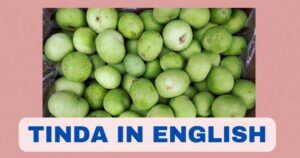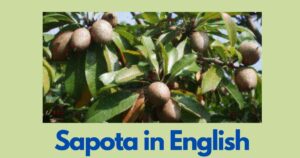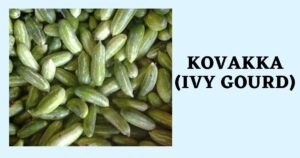Maravalli Kilangu in English
- The English name of Maravalli Kilangu is “Tapioca” or “Cassava”.

Maravalli Kilangu / Maravalli Kizhangu
Maravalli Kilangu, also known as Maravalli Kizhangu or Kuchi Kilangu, is a type of tuber commonly found in South India. In English, it is often referred to as “Tapioca.” This starchy root vegetable is derived from the cassava plant (Manihot esculenta) and is a significant source of carbohydrates in many tropical regions around the world.
Maravalli Kilangu (Kuchi Kilangu) is used to make a variety of dishes in South Indian cuisine. It can be boiled, steamed, or fried, and it is often used in dishes like “Tapioca Kappa,” where it is cooked with spices, coconut, and sometimes with fish or other ingredients. Tapioca pearls and tapioca flour, made from this root, are also used in various culinary applications, including desserts, snacks, and thickening agents in recipes.
It’s important to note that while tapioca is a versatile and popular ingredient, it should be prepared and cooked properly, as the raw cassava plant contains naturally occurring cyanogenic glycosides, which can be toxic if not processed correctly. Proper cooking, soaking, and draining are essential to remove these compounds, making the tapioca safe to eat.
BUY MARAVALLI KILANGU PRODUCTS ONLINE
Maravalli Kilangu Benefits
Maravalli Kilangu, or Kuchi Kilangu, offers several potential benefits due to its nutritional content and properties:
- Rich Source of Carbohydrates: Tapioca is primarily composed of carbohydrates, making it an excellent source of energy.
- Low in Fat and Cholesterol: It is naturally low in fat and cholesterol, making it a heart-healthy food choice.
- Gluten-Free: Tapioca is naturally gluten-free, making it suitable for individuals with celiac disease or gluten sensitivity.
- Good Source of Fiber: It contains dietary fiber, which can aid in digestion and help prevent constipation.
- Rich in Vitamins and Minerals: Tapioca provides essential vitamins and minerals, including vitamin C, folate, and various B vitamins, as well as minerals like calcium, iron, and phosphorus.
- Provides Resistant Starch: Tapioca contains resistant starch, which can act as a prebiotic and support gut health.
- Easily Digestible: The starch in tapioca is easily digestible, making it suitable for individuals with digestive issues or sensitive stomachs.
- Versatile Ingredient: Tapioca can be used in various culinary applications, from savory to sweet dishes, enhancing the diversity of your diet.
- Alternative Flour: Tapioca flour (or tapioca starch) is a common gluten-free flour substitute in baking and cooking.
- Satiety: The fiber and resistant starch in tapioca may help promote a feeling of fullness, which can aid in weight management.
- Potential Energy Boost: Due to its carbohydrate content, tapioca can provide a quick source of energy when needed.
- Cultural Significance: Tapioca is a staple in many traditional cuisines, contributing to the cultural heritage and culinary traditions of various regions.
Maravalli Kilangu for Weight Loss
Maravalli Kilangu can be a part of a weight loss diet when consumed in moderation and as part of a well-balanced, calorie-controlled meal plan. However, it’s essential to keep in mind that tapioca is primarily a source of carbohydrates, so you should be mindful of portion sizes and how you prepare it to support your weight loss goals.
Here are some tips for incorporating tapioca into a weight loss plan:
- Portion Control: Keep your serving sizes small. Tapioca is calorie-dense due to its carbohydrate content, so controlling portion sizes is crucial.
- Preparation Method: Opt for healthier cooking methods like boiling or steaming rather than frying, which can add extra calories from oil.
- Avoid Excess Fat: When using tapioca in recipes, avoid adding excessive fats like coconut milk or ghee, which can increase calorie intake.
- Combine with Lean Proteins and Vegetables: To create balanced meals, include lean proteins (e.g., grilled chicken, tofu, legumes) and plenty of vegetables alongside tapioca. This helps increase the feeling of fullness and adds nutritional variety.
- Fiber-Rich Accompaniments: Serve tapioca with fiber-rich foods like salads or vegetables to promote satiety.
- Limit High-Calorie Toppings: If you enjoy tapioca in desserts, use low-calorie sweeteners and toppings, such as fresh fruit or a small amount of honey or yogurt.
- Moderation: While tapioca can be a part of your weight loss plan, it should not be the main source of calories in your diet. Ensure that your overall calorie intake aligns with your weight loss goals.
- Monitor Total Caloric Intake: Keep track of your daily calorie intake to ensure you are creating a calorie deficit, which is essential for weight loss.
- Balanced Diet: Remember that weight loss is about the overall balance of your diet. Incorporate a variety of foods to ensure you get all the necessary nutrients.
- Consult a Dietitian: If you have specific weight loss goals or dietary restrictions, consider consulting with a registered dietitian or nutritionist who can help create a personalized meal plan.








